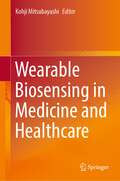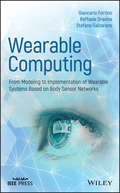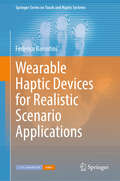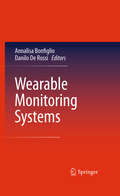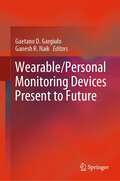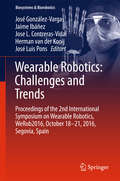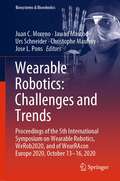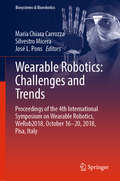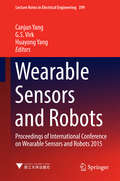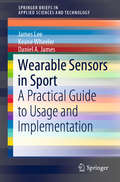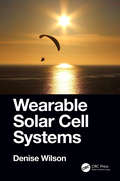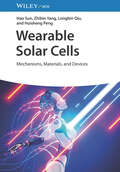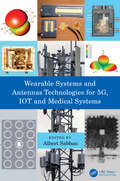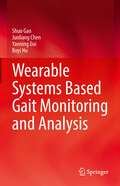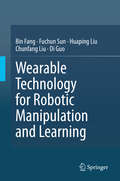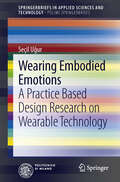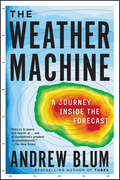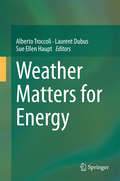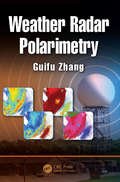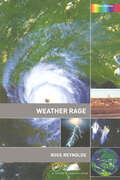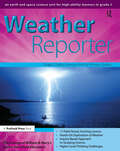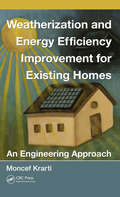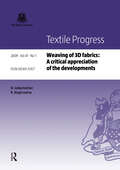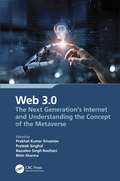- Table View
- List View
Wearable Biosensing in Medicine and Healthcare
by Kohji MitsubayashiThis book contains chapters on wearable biomedical sensors and their assistive technologies for promoting behavioral change in medical and health care. Part I reviews several wearable biomedical sensors based on biocompatible materials and nano and micro-electromechanical systems (MEMS) technologies in the medical and dental fields. Part II introduces the latest approaches to wearable biosensing using unique devices for various skin targets such as sweat, interstitial fluid, and transcutaneous gases. Part III presents technologies supporting wearable sensors, including soft and flexible materials, manufacturing methods, skin volatile-marker imaging, and energy harvesting devices.This book is intended for graduate students, academic researchers, and professors that work in medical and healthcare research fields, as well as industry professionals involved in the development of wearable and flexible sensing devices and measurement systems for human bio/chemical sensing, medical monitoring, and healthcare services, and for medical professionals and government officials who are driving behavior change in health care.
Wearable Computing: From Modeling to Implementation of Wearable Systems based on Body Sensor Networks (Wiley - IEEE)
by Giancarlo Fortino Raffaele Gravina Stefano GalzaranoThis book provides the most up-to-date research and development on wearable computing, wireless body sensor networks, wearable systems integrated with mobile computing, wireless networking and cloud computing This book has a specific focus on advanced methods for programming Body Sensor Networks (BSNs) based on the reference SPINE project. It features an on-line website (http://spine.deis.unical.it) to support readers in developing their own BSN application/systems and covers new emerging topics on BSNs such as collaborative BSNs, BSN design methods, autonomic BSNs, integration of BSNs and pervasive environments, and integration of BSNs with cloud computing. The book provides a description of real BSN prototypes with the possibility to see on-line demos and download the software to test them on specific sensor platforms and includes case studies for more practical applications. • Provides a future roadmap by learning advanced technology and open research issues • Gathers the background knowledge to tackle key problems, for which solutions will enhance the evolution of next-generation wearable systems • References the SPINE web site (http://spine.deis.unical.it) that accompanies the text• Includes SPINE case studies and span topics like human activity recognition, rehabilitation of elbow/knee, handshake detection, emotion recognition systemsWearable Systems and Body Sensor Networks: from modeling to implementation is a great reference for systems architects, practitioners, and product developers. Giancarlo Fortino is currently an Associate Professor of Computer Engineering (since 2006) at the Department of Electronics, Informatics and Systems (DEIS) of the University of Calabria (Unical), Rende (CS), Italy. He was recently nominated Guest Professor in Computer Engineering of Wuhan University of Technology on April, 18 2012 (the term of appointment is three years). His research interests include distributed computing and networks, wireless sensor networks, wireless body sensor networks, agent systems, agent oriented software engineering, streaming content distribution networks, distributed multimedia systems, GRID computing.Raffaele Gravina received the B.Sc. and M.S. degrees both in computer engineering from the University of Calabria, Rende, Italy, in 2004 and 2007, respectively. Here he also received the Ph.D. degree in computer engineering. He's now a Postdoctoral research fellow at University of Calabria. His research interests are focused on high-level programming methods for WSNs, specifically Wireless Body Sensor Networks. He wrote almost 30 scientific/technical articles in the area of the proposed Book. He is co-founder of SenSysCal S.r.l., a spin-off company of the University of Calabria, and CTO of the wearable computing area of the company.Stefano Galzarano received the B.S. and M.S. degrees both in computer engineering from the University of Calabria, Rende, Italy, in 2006 and 2009, respectively. He is currently pursuing a joint Ph.D. degree in computer engineering with University of Calabria and Technical University of Eindhoven (The Netherlands). His research interests are focused on high-level programming methods for wireless sensor networks and, specifically, novel methods and frameworks for autonomic wireless body sensor networks.
Wearable Haptic Devices for Realistic Scenario Applications (Springer Series on Touch and Haptic Systems)
by Federica BarontiniThis book delves into the application of wearable haptic feedback technology in various contexts, focusing on prosthetics for individuals with upper limb loss and navigation systems for the visually impaired. Central to the book is the development of technologies that address users' needs and demands. It highlights the pivotal role of a user-centred approach in designing and creating novel feedback mechanisms. Beginning with focus groups and experimental campaigns, each chapter introduces innovative haptic devices that are characterized, tested, and refined to consistently meet user requirements. The research culminates in the creation of a fully integrated feedback system within a prosthetic socket. This book provides comprehensive insights into developing practical, user-friendly haptic devices that significantly improve the quality of life for individuals with sensory impairments.
Wearable Monitoring Systems
by Annalisa Bonfiglio Danilo De RossiAs diverse as tomorrow's society constituent groups may be, they will share the common requirements that their life should become safer and healthier, offering higher levels of effectiveness, communication and personal freedom. The key common part to all potential solutions fulfilling these requirements is wearable embedded systems, with longer periods of autonomy, offering wider functionality, more communication possibilities and increased computational power. As electronic and information systems on the human body, their role is to collect relevant physiological information, and to interface between humans and local and/or global information systems. Within this context, there is an increasing need for applications in diverse fields, from health to rescue to sport and even remote activities in space, to have real-time access to vital signs and other behavioral parameters for personalized healthcare, rescue operation planning, etc. This book's coverage will span all scientific and technological areas that define wearable monitoring systems, including sensors, signal processing, energy, system integration, communications, and user interfaces. Six case studies will be used to illustrate the principles and practices introduced.
Wearable/Personal Monitoring Devices Present to Future
by Gaetano D. Gargiulo Ganesh R. NaikThis book discusses recent advances in wearable technologies and personal monitoring devices, covering topics such as skin contact-based wearables (electrodes), non-contact wearables, the Internet of things (IoT), and signal processing for wearable devices. Although it chiefly focuses on wearable devices and provides comprehensive descriptions of all the core principles of personal monitoring devices, the book also features a section on devices that are embedded in smart appliances/furniture, e.g. chairs, which, despite their limitations, have taken the concept of unobtrusiveness to the next level. Wearable and personal devices are the key to precision medicine, and the medical community is finally exploring the opportunities offered by long-term monitoring of physiological parameters that are collected during day-to-day life without the bias imposed by the clinical environment. Such data offers a prime view of individuals’ physical condition, as well as the efficacy of therapy and occurrence of events. Offering an in-depth analysis of the latest advances in smart and pervasive wearable devices, particularly those that are unobtrusive and invisible, and addressing topics not covered elsewhere, the book will appeal to medical practitioners and engineers alike.
Wearable Robotics: Challenges and Trends
by José González-Vargas Jaime Ibáñez Jose L. Contreras-Vidal Herman van der Kooij José Luis PonsThe book reports on advanced topics in the areas of wearable robotics research and practice. It focuses on new technologies, including neural interfaces, soft wearable robots, sensors and actuators technologies, and discusses important regulatory challenges, as well as clinical and ethical issues. Based on the 2nd International Symposium on Wearable Robotics, WeRob2016, held October 18-21, 2016, in Segovia, Spain, the book addresses a large audience of academics and professionals working in government, industry, and medical centers, and end-users alike. It provides them with specialized information and with a source of inspiration for new ideas and collaborations. It discusses exemplary case studies highlighting practical challenges related to the implementation of wearable robots in a number of fields. One of the focus is on clinical applications, which was encouraged by the colocation of WeRob2016 with the International Conference on Neurorehabilitation, INCR2016. Additional topics include space applications and assistive technologies in the industry. The book merges together the engineering, medical, ethical and political perspectives, thus offering a multidisciplinary, timely snapshot of the field of wearable technologies.
Wearable Robotics: Proceedings of the 5th International Symposium on Wearable Robotics, WeRob2020, and of WearRAcon Europe 2020, October 13–16, 2020 (Biosystems & Biorobotics #27)
by Juan C. Moreno Jawad Masood Urs Schneider Christophe Maufroy Jose L. PonsThis book reports on advanced topics in the areas of wearable robotics research and practice. It focuses on new technologies, including neural interfaces, soft wearable robots, sensors and actuators technologies, discussing industrially and medically-relevant issues, as well as legal and ethical aspects. It covers exemplary case studies highlighting challenges related to the implementation of wearable robots for different purposes, and describing advanced solutions. Based on the 5th International Symposium on Wearable Robotics, WeRob2020, and on WearRacon Europe 2020, which were both held online on October 13-16, 2020, the book addresses a large audience of academics and professionals working in for the government, in the industry, and in medical centers, as well as end-users alike. By merging together engineering, medical, ethical and industrial perspectives, it offers a multidisciplinary, timely snapshot of the field of wearable technologies.
Wearable Robotics: Proceedings of the 4th International Symposium on Wearable Robotics, WeRob2018, October 16-20, 2018, Pisa, Italy (Biosystems & Biorobotics #22)
by José L. Pons Silvestro Micera Maria Chiara CarrozzaThe book reports on advanced topics in the areas of wearable robotics research and practice. It focuses on new technologies, including neural interfaces, soft wearable robots, sensors and actuators technologies, and discusses important regulatory challenges, as well as clinical and ethical issues. Based on the 4th International Symposium on Wearable Robotics, WeRob2018, held October 16-20, 2018, in Pisa, Italy, the book addresses a large audience of academics and professionals working in government, industry, and medical centers, and end-users alike. It provides them with specialized information and with a source of inspiration for new ideas and collaborations. It discusses exemplary case studies highlighting practical challenges related to the implementation of wearable robots in a number of fields. One of the focus is on clinical applications, which was encouraged by the colocation of WeRob2018 with the International Conference on Neurorehabilitation, INCR2018. Additional topics include space applications and assistive technologies in the industry. The book merges together the engineering, medical, ethical and political perspectives, thus offering a multidisciplinary, timely snapshot of the field of wearable technologies.
Wearable Sensors and Robots
by Canjun Yang G. S. Virk Huayong YangThese proceedings present the latest information on regulations and standards for medical and non-medical devices, including wearable robots for gait training and support, design of exoskeletons for the elderly, innovations in assistive robotics, and analysis of human-machine interactions taking into account ergonomic considerations. The rapid development of key mechatronics technologies in recent years has shown that human living standards have significantly improved, and the International Conference on Wearable Sensor and Robot was held in Hangzhou, China from October 16 to 18, 2015, to present research mainly focused on personal-care robots and medical devices. The aim of the conference was to bring together academics, researchers, engineers and students from across the world to discuss state-of-the-art technologies related to various aspects of wearable sensors and robots.
Wearable Sensors in Sport: A Practical Guide to Usage and Implementation (SpringerBriefs in Applied Sciences and Technology)
by James Lee Keane Wheeler Daniel A. JamesDrawing on 15 years of experience in the development and use of wearable sensors in sports science, this book bridges the gap between technical research and the widespread adoption of inertial sensors in biomechanical assessment and ambulatory studies of locomotion. It offers a 'no-nonsense' guide to using inertial sensors for readers from the sports science disciplines who may be unfamiliar with the terms, concepts and approaches that lead to these sensors’ successful use. At the same time, the book introduces readers with a technical background, e.g. in engineering, to sport science methodologies that can provide valuable insights into the use of sensors in a practical environment that extends well beyond bench testing.
Wearable Solar Cell Systems
by Denise WilsonSmartwatch? Fitness tracker? Portable ECG? Smartphone? Posture monitor? Hearing aid? MP3 player? E-reader? Wireless headset? Hiking watch? Gaming headset? Sleep monitor? Laptop computer? Tablet? Indeed, a dizzying array of portable and wearable electronic devices is available to the modern consumer. Not surprisingly, as the number of devices an individual chooses to wear or carry increases so does the energy required to power those devices. Judging by the increasing popularity of portable power banks, waiting to recharge many of these devices using standard wall outlets is no longer a standard practice. Wearable Solar Cell Systems looks at the possibilities for supporting the energy demand of these devices without the need to return to the dreaded wall outlet for recharging. While crystalline silicon dominates world markets, second- or third-generation solar cell technologies may be more suitable to wearable systems. Array size, architecture, and management must also be chosen to best serve portable and wearable devices and harvest light energy from different light sources under a broad range of input conditions. This book is intended to serve a wide audience from students who desire a basic introduction to solar (photovoltaic) cell technology to professionals seeking a holistic picture of wearable solar cells and systems.
Wearable Solar Cells: Mechanisms, Materials, and Devices
by Hao Sun Zhibin Yang Longbin Qiu Huisheng PengWearable Solar Cells Understand a groundbreaking new energy technology Solar energy is one of the most important paths to a sustainable future. In recent years, extensive research and development has begun to produce wearable solar cells, whose novel planar and fiber format gives them enormous flexibility and a wide range of potential uses. The possibility of a solar energy source that can be fitted to the human body promises to become an extraordinary tool for meeting various kinds of personal energy needs. Wearable Solar Cells: Mechanisms, Materials, and Devices serves as a comprehensive introduction to this cutting-edge technology and its applications. Recent research pointing towards fiber-format solar cells as a bold new frontier is summarized and explored. The result is an essential resource for both experienced researchers and newcomers to the field. Wearable Solar Cells readers will also find: Close coverage of integrated energy harvesting and storage devices Detailed discussion of dye-sensitized solar cells, polymer solar cells, perovskite solar cells, and more An authorial team with decades of combined research experience Wearable Solar Cells is ideal for materials scientists, polymer chemists, electrical engineers, solid-state physicists, and advanced students interested in these and related topics.
Wearable Systems and Antennas Technologies for 5G, IOT and Medical Systems
by Albert SabbanDue to progress in the development of communication systems, it is now possible to develop low-cost wearable communication systems. A wearable antenna is meant to be a part of the clothing or close to the body and used for communication purposes, which include tracking and navigation, mobile computing and public safety. Examples include smartwatches (with integrated Bluetooth antennas), glasses (such as Google Glass with Wi-Fi and GPS antennas), GoPro action cameras (with Wi-Fi and Bluetooth antennas), etc. They are increasingly common in consumer electronics and for healthcare and medical applications. However, the development of compact, efficient wearable antennas is one of the major challenges in the development of wearable communication and medical systems. Technologies such as printed compact antennas and miniaturization techniques have been developed to create efficient, small wearable antennas which are the main objective of this book. Each chapter covers enough mathematical detail and explanations to enable electrical, electromagnetic and biomedical engineers and students and scientists from all areas to follow and understand the topics presented. New topics and design methods are presented for the first time in the area of wearable antennas, metamaterial antennas and fractal antennas. The book covers wearable antennas, RF measurements techniques and measured results in the vicinity of the human body, setups and design considerations. The wearable antennas and devices presented in this book were analyzed by using HFSS and ADS 3D full-wave electromagnetics software. Explores wearable medical systems and antennas Explains the design and development of wearable communication systems Explores wearable reconfigurable antennas for communication and medical applications Discusses new types of metamaterial antennas and artificial magnetic conductors (AMC) Reviews textile antennas Dr. Albert Sabban holds a PhD in Electrical Engineering from the University of Colorado at Boulder, USA (1991), and an MBA from the Faculty of Management, Haifa University, Israel (2005). He is currently a Senior Lecturer and researcher at the Department of Electrical and Electronic Engineering at Kinneret and Ort Braude Engineering Colleges.
Wearable Systems Based Gait Monitoring and Analysis
by Shuo Gao Junliang Chen Yanning Dai Boyi HuWearable Systems Based Gait Monitoring and Analysis provides a thorough overview of wearable gait monitoring techniques and their use in health analysis. The text starts with an examination of the relationship between the human body’s physical condition and gait, and then introduces and explains nine mainstream sensing mechanisms, including piezoresistive, resistive, capacitive, piezoelectric, inductive, optical, air pressure, EMG and IMU-based architectures. Gait sensor design considerations in terms of geometry and deployment are also introduced. Diverse processing algorithms for manipulating sensors outputs to transform raw data to understandable gait features are discussed. Furthermore, gait analysis-based health monitoring demonstrations are given at the end of this book, including both medical and occupational applications. The book will enable students of biomedical engineering, electrical engineering, signal processing, and ergonomics and practitioners to understand the medical and occupational applications of engineering-based gait analysis and falling injury prevention methods.
Wearable Technology for Robotic Manipulation and Learning
by Bin Fang Fuchun Sun Huaping Liu Chunfang Liu Di GuoOver the next few decades, millions of people, with varying backgrounds and levels of technical expertise, will have to effectively interact with robotic technologies on a daily basis. This means it will have to be possible to modify robot behavior without explicitly writing code, but instead via a small number of wearable devices or visual demonstrations. At the same time, robots will need to infer and predict humans’ intentions and internal objectives on the basis of past interactions in order to provide assistance before it is explicitly requested; this is the basis of imitation learning for robotics. This book introduces readers to robotic imitation learning based on human demonstration with wearable devices. It presents an advanced calibration method for wearable sensors and fusion approaches under the Kalman filter framework, as well as a novel wearable device for capturing gestures and other motions. Furthermore it describes the wearable-device-based and vision-based imitation learning method for robotic manipulation, making it a valuable reference guide for graduate students with a basic knowledge of machine learning, and for researchers interested in wearable computing and robotic learning.
Wearing Embodied Emotions
by Seçil UğurToday, people are in an era of digitally mediated Human-to-Human Interaction, which cannot provide full sensorial contact and therefore, emotions cannot be communicated completely. The intimate cover of the human body, i.e. garment is the interface, where many personal traits are embodied. With the improvements in textile and electronics industry, this embodiment can be carried on a higher level, where the garments become dynamic interfaces and extensions of the human body. This book consists of a research on skin, clothes and technology as extensions of human body, emotions, technology-mediated emotions and a design practice that explores the communicative level of wearable technology through turning it into a living surface, which can convert intangible data to tangible in order to provide an emotional communication. This book aims to show how Human-Technology interaction is carried into an alternative context, where technology dissolves in use and starts serving for enhancing HHI.
The Weather Machine: A Journey Inside the Forecast
by Andrew BlumFrom the acclaimed author of Tubes, a lively and surprising tour of the infrastructure behind the weather forecast, the people who built it, and what it reveals about our climate and our planetThe weather is the foundation of our daily lives. It’s a staple of small talk, the app on our smartphones, and often the first thing we check each morning. Yet behind these quotidian interactions is one of the most expansive machines human beings have ever constructed—a triumph of science, technology and global cooperation. But what is this ‘weather machine’ and who created it? In The Weather Machine, Andrew Blum takes readers on a fascinating journey through an everyday miracle. In a quest to understand how the forecast works, he visits old weather stations and watches new satellites blast off. He follows the dogged efforts of scientists to create a supercomputer model of the atmosphere and traces the surprising history of the algorithms that power their work. He discovers that we have quietly entered a golden age of meteorology—our tools allow us to predict weather more accurately than ever, and yet we haven’t learned to trust them, nor can we guarantee the fragile international alliances that allow our modern weather machine to exist.Written with the sharp wit and infectious curiosity Andrew Blum is known for, The Weather Machine pulls back the curtain on a universal part of our everyday lives, illuminating our relationships with technology, the planet, and the global community.
Weather Matters for Energy
by Alberto Troccoli Laurent Dubus Sue Ellen HauptIt is the purpose of this book to provide the meteorological knowledge and tools to improve the risk management of energy industry decisions, ranging from the long term finance and engineering planning assessments to the short term operational measures for scheduling and maintenance. Most of the chapters in this book are based on presentations given at the inaugural International Conference Energy & Meteorology (ICEM), held in the Gold Coast, Australia, 8-11 November 2011. The main aim of the conference was to strengthen the link between Energy and Meteorology, so as to make meteorological information more relevant to the planning and operations of the energy sector. The ultimate goal would be to make the best use of weather and climate data in order to achieve a more efficient use of energy sources. This book seeks to realise the same objective.
Weather Radar Polarimetry
by Guifu ZhangThis book presents the fundamentals of polarimetric radar remote sensing through understanding wave scattering and propagation in geophysical media filled with hydrometers and other objects. The text characterizes the physical, statistical, and electromagnetic properties of hydrometers and establishes the relations between radar observables and physical state parameters. It introduces advanced remote sensing techniques (such as polarimetric phased array radar) and retrieval methods for physical parameters. The book also illustrates applications of polarimetric radar measurements in hydrometer classification, particle size distribution retrievals, microphysical parameterization, and weather quantification and forecast.
Weather Rage (Science Spectra)
by Ross ReynoldsSome atmospheric disturbances produce the kind of extreme weather events making the national and international new headlines on a regular basis. Just about everyone is interested in knowing more about hurricanes, typhoons and tornadoes. There is often confusion about whether or not they are the same thing and whether, for example, we can control th
Weather Reporter: An Earth and Space Science Unit for High-Ability Learners in Grade 2
by Clg Of William And Mary/Ctr Gift EdWeather Reporter, a second-grade Earth and space science unit, provides students with opportunities in a scenario-based approach to observe, measure, and analyze weather phenomena. The overarching concept of change reinforces students' decisions as they learn about the changes in the Earth's weather and observe, measure, and forecast the weather.Weather Reporter was developed by the Center for Gifted Education at The College of William and Mary to offer advanced curriculum supported by years of research. The Center's materials have received national recognition from the United States Department of Education and the National Association for Gifted Children, and they are widely used both nationally and internationally.Each of the books in this series offers curriculum that focuses on advanced content and higher level processes. The science units contain simulations of real-world problems, and students experience the work of real science by using data-handling skills, analyzing information, and evaluating results. The mathematics units provide sophisticated ideas and concepts, challenging extensions, higher order thinking skills, and opportunities for student exploration based on interest. These materials are a must for any teacher seeking to challenge and engage learners and increase achievement.Grade 2
Weathering of Polymers and Plastic Materials
by Luís Eduardo RealThis book presents the state of the art on the weathering of polymers and plastic materials in outdoor applications, comprising natural weathering, accelerated climatic weathering, laboratory artificial accelerated weathering, and lifetime prediction methodology. It summarizes the most suitable methods of instrumental analysis to access and quantify (when possible) degradation caused by weathering, while also covering the degradation and stabilization of polymers based on environmental and artificially induced factors. Innovative polymer additives and some developments in polymeric materials designed for outdoor applications are also included, emphasizing a few selected cases. the book intends to be an important reference source for those involved in the study of the durability of polymers and plastics, production of plastics for exterior applications, chemists responsible for quality control of plastic products, and researchers and students across plastics engineering, polymer science, polymer chemistry and environmental science.
Weatherization and Energy Efficiency Improvement for Existing Homes: An Engineering Approach (Mechanical and Aerospace Engineering Series)
by Moncef KrartiProviding a proven set of energy efficiency measures and opportunities for saving energy and reducing operating costs for existing homes, this volume presents general tools and procedures for performing home weatherization such as insulation improvements as well as methods to reduce air leakage. The author describes several techniques and technolog
Weaving of 3D Fabrics: A Critical Appreciation of the Developments
by N. Gokarneshan R. AlagirusamyThis book, volume 41.1 of the journal Textile Progress, critically reviews the various developments that have taken place in weaving 3D fabrics. It explains how fabrics can be woven with different structures and profiles to fit specific requirements for a variety of end-use applications. The text highlights the unique features of each method and points out the major differences between the 2D and 3D methods of weaving, including the use of 3D fabrics in technical applications. It also explores how methods have evolved for producing 3D fabrics to be used as advanced composite performs as well as a bifurcated vascular prosthesis.
Web 3.0: The Next Generation's Internet and Understanding the Concept of the Metaverse
by Prateek Singhal Prabhat Kumar Srivastav Basudeo Singh Roohani Nitin SharmaThe book underscores AI's transformative impact on reshaping physical, digital, and biological boundaries, converging with technologies like robotics, IoT, 3D printing, genetic engineering, and quantum computing—termed Web 3.0 Industrial Revolution. This global revolution integrates advanced production techniques beyond connected machines, extending into gene sequencing, nanotechnology, renewable energies, and quantum computing. The book's main goals include providing a collaborative platform for academia and industry researchers to share contributions and shape the future through knowledge exchange. Recognizing recent progress driven by increased computing power, it highlights the positive impact of digital technology—AI, IoT, AR/VR, Additive Manufacturing, CPS, cloud computing, and robotics—on industrial efficiency and quality. Revolutionary AI Fusion: AI revolutionizes by blending physical, digital, and biological boundaries through cutting-edge technologies like robotics, IoT, 3D printing, genetic engineering, and quantum computing. Global Manufacturing Cooperation: AI creates a collaborative landscape where virtual and physical systems flexibly cooperate on a global scale. AI's Diverse Impact: Beyond smart machines, AI drives breakthroughs in gene sequencing, nanotechnology, renewable energies, and quantum computing, distinguishing it from prior industrial revolutions. Progress and Digital Interface: Recent progress, powered by computing advancements, boosts industrial efficiency. The digital technology interface (AI, IoT, AR/VR, 3D Printing, CPS, CC, Robotics) significantly impacts industrial performance. In conclusion, AI spearheads a transformative revolution, redefining the boundaries of the physical, digital, and biological realms. The fusion of AI with Web 3.0 Industrial Revolution, integrating advanced production techniques and global manufacturing cooperation, surpassing past industrial shifts. The book aims to be a collaborative platform for academia and industry researchers, fostering knowledge exchange to shape the future. In AI-driven manufacturing within Web 3.0, a paradigm shift envisions maximum output with minimal resource use. Coupled with 'Digital Reality,' it transforms business practices, consumer behaviour, and employment dynamics, redistributing wealth toward innovation and technology.
